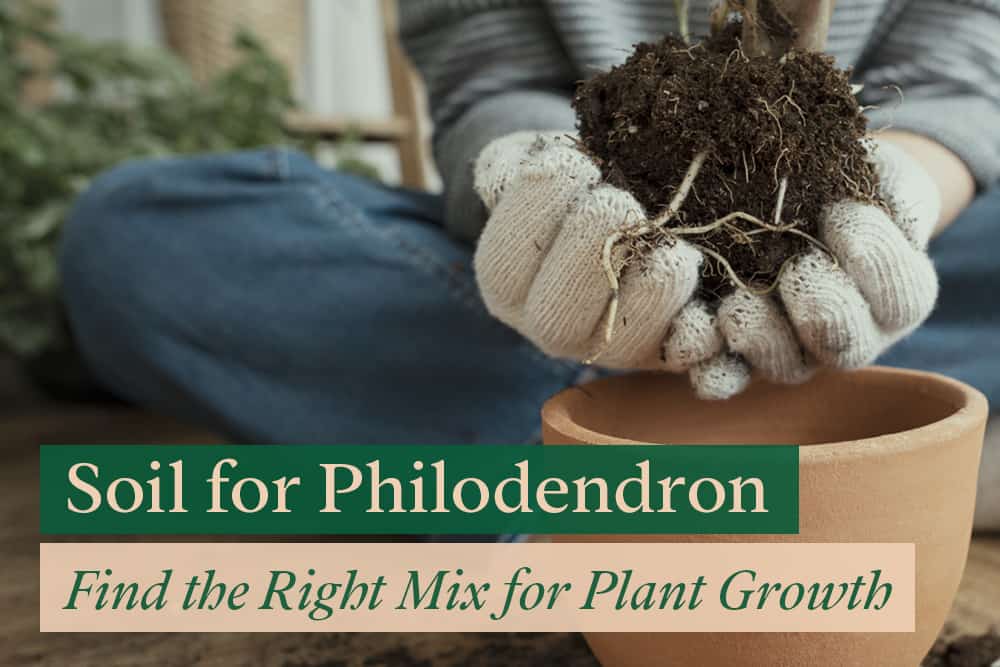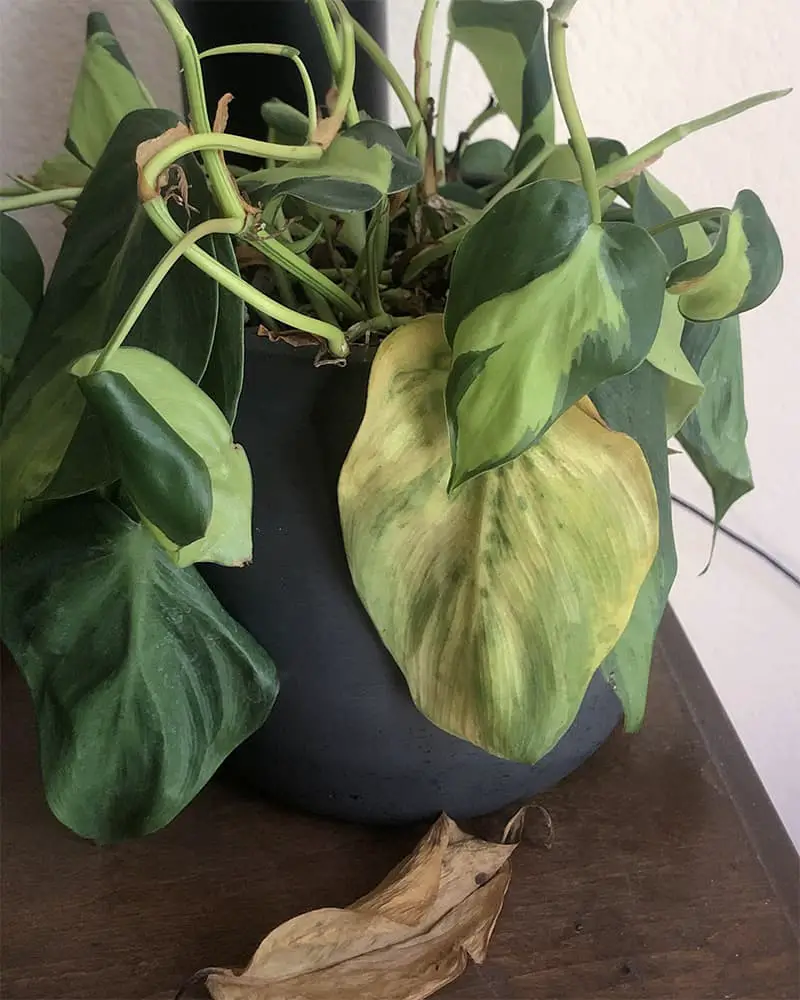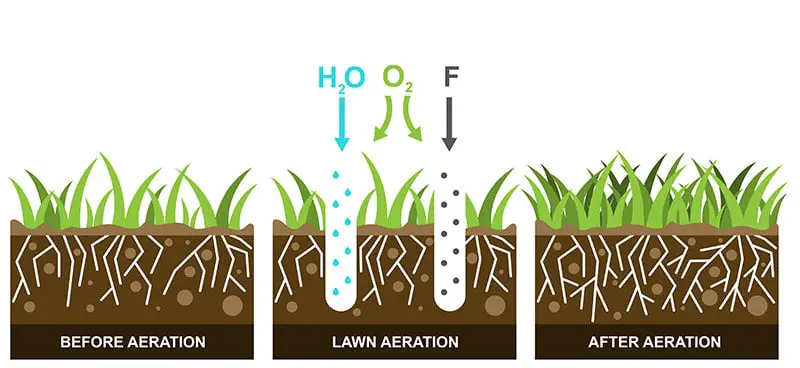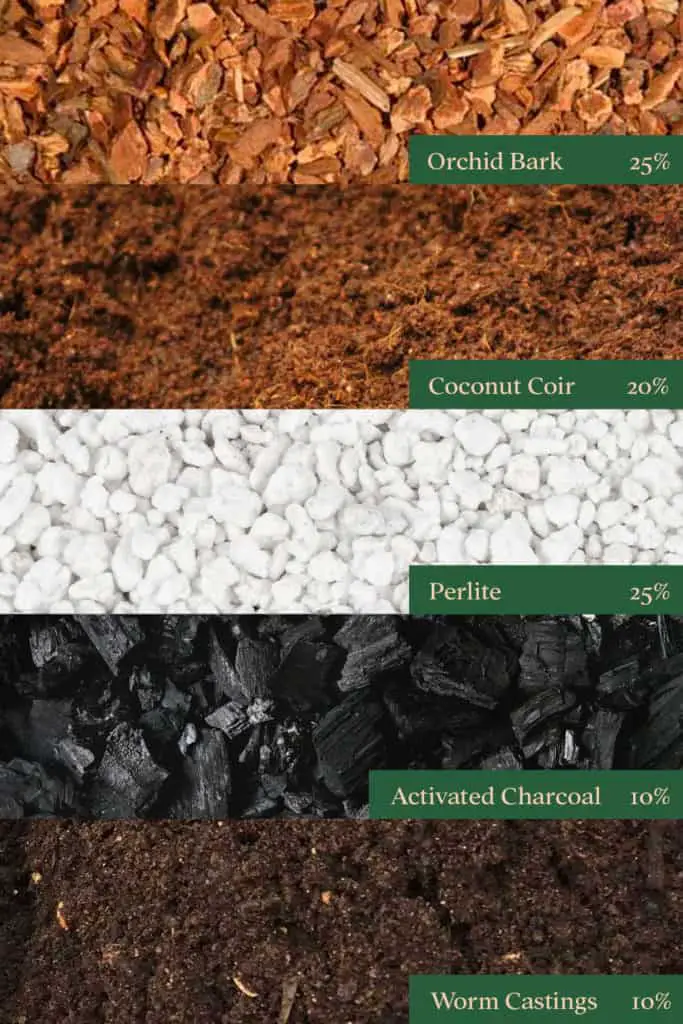
Has your Philodendron stopped growing or is it suffering from root rot? This may be caused by the wrong soil mix you are using in the pot.
In general, Philodendron prefers an airy and well-draining soil mix. In addition, the plant will grow best in soil that is slightly acidic (pH level between 6 and 6.5) and contains sufficient Nitrogen, Phosphorus, Potassium, and Magnesium.
Here is all the information you need on growing Philodendrons in the appropriate soil mix:
- Signs you are using the wrong soil mix
- Ideal potting mix qualities for Philodendron
- How to create your own soil mix for Philodendron (+recipe)
- Best ready-made potting mix for Philodendron
- Factors affecting your potting mix’s ingredient selection
Let’s get started!
Bloomsprouts may earn an affiliate commission if you purchase something through recommended links.
Signs You Are Using the Wrong Soil Mix
Philodendrons have specific soil requirements, and when they’re not met, the plant will struggle to grow and develop.
Here are the key signs you are using the wrong soil mix for your philodendron:
Soil Not Drying Out
Philodendrons require well-draining soil. Therefore, if the soil around your philodendron never fully dries out, it may mean that you need to improve drainage so that the plant can thrive.
When the soil never dries out, the philodendron will not only cease to develop correctly, but it may also develop root rot.
Essentially, stagnant water is a perfect breeding ground for bacteria and other harmful contaminants that can damage the Philodendron root system.
Soil is Dense and Compact
Compact and dense soil is another common problem for philodendron plants. Highly compacted soil is tough for plants to grow in since oxygen and water are hard to penetrate and reach the roots. Therefore, philodendrons prefer loose and airy soil.

Ideally, you should be able to easily push your finger into the soil. Therefore, if you find that it is difficult to push your finger down the soil and it feels solid to the touch, then your soil is too dense for philodendrons.
Alternatively, you can use a piece of metal wire to mark the depth at which the wire bends and can’t be pushed down straight. The earlier it bends, the more compact the soil is.
Leaves are Curling and Yellowing
When your philodendron roots are waterlogged, the plant often responds with curled and yellowing leaves. The leaves will also feel soft and limp when touched.
Also, planting your philodendron in the wrong soil mix can prevent the plant from getting all the nutrients it needs to thrive.
In my experience, manganese, zinc, and nitrogen deficiencies usually cause yellowing on inner or older leaves first and then progress outward.
Philodendron not Growing or Wilting
As the roots are unable to absorb enough water, oxygen, and nutrients, the plant cannot undergo photosynthesis and produce enough energy to support growth.
Furthermore, if this condition persists too long, the plant’s cells will be damaged and eventually die due to a lack of energy. Plants that lose their cells will start to wilt.
Therefore, if your Philodendrons are wilting and not growing, you may be using the wrong soil mix.
Soil Smells Bad
Another common issue that philodendron owners have is terrible smells coming from the soil beneath your plant.
A foul smell is caused when your soil mix develops root rot or has a build-up of harmful bacteria.
This can be very unpleasant, significantly when growing plants indoors. Foul smells from the soil indicate that it’s time to change the soil mix.
Philodendron May Become Dehydrated
Philodendrons enjoy loose soil with plenty of drainages. However, too much drainage can also be an issue as the water passes through the soil before the plant gets a chance to absorb any moisture.
The result is dry soil that’s harsh and unsuitable for philodendron development.

When philodendrons receive too little water, they’ll start to turn brown and wilt. This is a critical indicator that the plant is dehydrated and needs more water.
It could also indicate that your soil mix is draining too quickly, which can happen if you use a cactus soil mix, as cacti grow in drier climates.
Philodendron Soil Mix Requirements
Now that you know what you need to keep an eye out for in your philodendron, it’s time to figure out your plant’s requirements from their soil mix. Different plants require different conditions to facilitate growth, so what conditions do philodendrons thrive in?
Philodendron requires the following conditions in the soil to flourish:
Aeration
Philodendrons require aeration in their soil. The plant flourishes when the soil is porous and has good airflow. As a result, you’ll require a soil mix that’s naturally loose and ensures good airflow.
Keep soil loose by using organic materials such as compost, peat moss, and manure, and by putting a layer of mulch on top of the soil.
You can also poke holes in the soil with a chopstick to allow more air to flow.

Philodendrons require air in the soil as their roots need oxygen to grow. Therefore, insufficient airflow in the soil will hamper root development. This can cause issues for the plant and prevent it from growing.
Well Draining
Philodendrons grow best in soil that is continuously moist but never saturated. As a result, the soil must have adequate drainage to prevent water from remaining for extended periods.
Therefore, the soil mix you use must have good drainage abilities. Using pots with holes in the bottom is another way to help provide adequate drainage for your philodendron.
If philodendrons are left in too much water, they become vulnerable to a whole host of problems. Water can allow harmful bacteria to develop along with mold.
This inevitably results in rot occurring to the roots of the plant. Therefore, philodendron soil must have adequate drainage.
Moisture Retention
Philodendrons, like all plants, require a balance of conditions for favorable growth. The plants require sufficient drainage in the soil, but they also require a certain level of water retention.
Without good water retention capability, the roots don’t have time to absorb the water needed for photosynthesis.
You can use the Squeeze test to determine how well your soil mix can retain water. Take a fistful of the wet soil and form it into a ball.
Does the ball fall apart immediately? If so, your soil does not retain water well. On the other hand, if the soil creates a hard lump, the soil retains too much moisture.
Soil should hold together in a ball and break apart when tapped. This indicates the soil holds enough water without being too saturated.
Ideally, the top layer of Philodendron soil should be dry, whereas the layer underneath should be moist to touch.
pH Levels
The pH levels are another influential factor in philodendron soil requirements. This variety of plant typically enjoys slightly acidic soil.
Generally, your Philodendron soil should have a pH level between 6.0 and 6.5. This is just slightly more acidic than neutral. If the pH is off in your philodendron soil, bacteria and nutrients that your plant needs to thrive can die off, resulting in harm to your philodendron.

In addition to this, some harmful bacteria can flourish when the pH levels are incorrect. This can lead to rot and disease forming in the philodendrons.
Nutrient Content
Philodendrons rely on beneficial bacteria and nutrients in the soil to thrive. As a result, the soil will require a healthy amount of nutrients to facilitate healthy growth.
Philodendrons require Nitrogen, Phosphorus, Potassium, and Magnesium in the soil to allow healthy development. These nutrients can be added to the soil using balance fertilizers once a month in the spring and summer months.
How to Mix Potting Soil for Philodendron (+Materials Needed)
Once you know what your philodendrons need from their soil, it’s time to start mixing the potting soil for your plant. Before we get to the steps of mixing the soil, we’ll need to discuss what you need to provide your philodendron with ideal soil for healthy growth.
Here are the materials that I use for mixing potting soil for my philodendron plants:

- Orchid bark (25%)
Bark chips are shredded or chipped tree bark that can be used in the soil. Their coarse texture aerates soil, prevents compaction, and facilitates drainage.
- Coconut coir (25%)
This organic coconut material is excellent for retaining moisture in the soil and facilitating drainage. Its water absorption capacity is ten times greater than its weight.
Adding perlites to your potting mix will make the soil more aerated and well-drained, making the soil less compact and better draining.
- Worm castings (10%)
Adding worm casting to your soil increases the nutrients that your plants require for growth. Additionally, it keeps the soil’s pH between 6 and 7, which is ideal for Philodendrons.
- Activated charcoal (5%)
Activated charcoal is a porous form of charcoal that has been treated with gas, heat, or chemicals. It can be used to repel insects while also preventing mold and absorbing excess moisture.
Alternative Materials
If you can’t find any of the materials listed above, here’s an alternative mixture that’s easier to source:
- Peat moss (30%)
Peat moss can be used as an alternative to coconut coir. Along with improving water retention and drainage, it is also capable of retaining nutrients and regulating the soil’s pH.
- Vermiculite (40%)
Vermiculite helps to aerate soil while simultaneously retaining water and nutrients. But, perlite is a better choice rather than vermiculate in my opinion since it provides better drainage.
- Potting soil (30%)
Philodendrons can receive all of the nutrients they need and meet all other requirements when placed in one of the above soil mixes. See below for the guide on mixing your soil materials for your philodendron.
How to Mix Soil Material for Philodendron
Once you’ve gathered your materials for your soil mix, it’s time to get started on your mix.
The process is simple.
You can put the ingredients in a bucket or large bin in the proportions listed above and stir them together with a gardening spoon or your hands.
Please wear gloves whenever handling any ingredients, including bark chips, as they can be somewhat rough on your hands. You don’t want a splinter in your hand!
People often make mistakes when they see gaps in the soil and then attempt to compact the soil. It squeezes the air out of the soil and compresses it, which puts the plant at risk of becoming overwatered.
My recommendation for Ready-Made Potting Soil
If you want to avoid the hassle of mixing your own soil, you can opt for ready-made potting soil. Ready-made potting soils save you a high amount of time and effort as you place them in the pot, add your plants, and you’re ready to go.
My recommendation for ready-made soil is FoxFarm Ocean Forest. This ready-made potting soil uses nutrients and materials from the land and the sea. This results in nutrient-rich and porous soil, ideal for philodendrons to flourish.
Other Factors Which May Affect Ingredient Choice in Your Soil Mix
Philodendrons can respond better to different soil mixes in different climates. Also, different species of philodendron can live better in different forms of soil.
On top of this, the way you look after your philodendron also significantly influences your choice of soil mix.
See below for the two significant factors which influence your ingredient choice for your soil mix:
Watering Habits
Do you water your plants every day? Or are you frequently forgetting to water because of a busy schedule?
Watering habits greatly influence the type of soil mix you should use for Philodendrons.
You may want to include more perlite (up to 70%) in your soil mix if you’re like me and enjoy watering your plants every 2 or 3 days. This will help prevent your Philodendron from being overwatered.
However, if you are busy, then you will need to increase the amount of coconut coir in your mix to ensure sufficient water retention.
By doing this, the plant will be able to get enough water between waterings even after excess moisture has been drained completely.
Temperature & Humidity Levels
Temperature and humidity also significantly impact your soil mix requirements for your Philodendrons.
When temperatures are high or the humidity is low around the plant, the plant will lose more water through both evaporation and transpiration.
Plants can quickly become dehydrated if the soil does not retain water properly. You should use more mulch on the topsoil, such as coconut fiber or wood chips.
On the other hand, when temperatures drop, Philodendrons become dormant and require less water. If the soil has inadequate drainage, overwatering can easily occur.
Repotting a Philodendron in the Winter, however, would be a terrible idea because it could stress the plant even more. You should cut back on watering instead. In the colder months, I usually water my Philodendron every two weeks.

